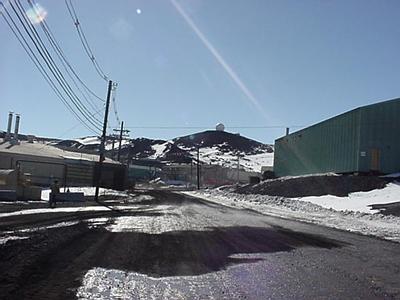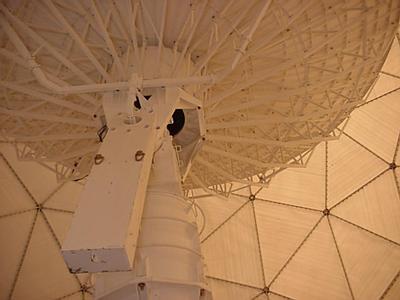4 December, 1999
Saturday December 4, 1999
Woke up at 0830 hours and would have slept longer, but tank personnel were
still partying from last night. I tried to do my laundry, I need it for
next week I am in the field, but the best I could do was wash it and then
lay it around my room to dry. It will dry because the humidity is so very
very low, but it would have been nice to be able to use the drier.
I got dressed and went to the supply building where each field party's
supplies are locked up in individual rooms. I went to our "cage" and could
not get the lock open. As I was fumbling with it and checking the
combinations this guy comes up and wants to know why was I am trying to get
into his supplies. I said I was not and I gave him my Science Event #
BM-042L. He was not impressed and gave me his, which matched the one
written in small print on the door. What is going on? I found this fellow
working there and told him what had happened, he took my event # and looked
it up. Check this out. I was in the wrong building. I guess I am not the
brightest light in the chandelier. Oh well, some times one must look like
what one is. A fool.
Having now found our stuff I gathered up materials for the field including
a backpack, crampons and a pea bottle. All the other supplies, tents and
sleep kits, etc. are already at Lake Hoare. I then brought these over to
the lab and got them weighed. I packed some stuff for Kathy, but she said
she had the rest. I spent the rest of the hour answering email.
About 1000 hours Barb and I met to debrief from our project. She left about
noon and I typed until 1415 hours. I then went to my room and gathered my
camera for I had scheduled a tour of the NASA 10-meter satellite antenna
facility for Barb and I at 1400 hours.
We went to their office where we were greeted by Erik Richards a sub
contractor for NASA who I had met on one of the trips to Cape Evans. NASA
has their own truck so we drove up to one of the tallest hills in town,
about 130 feet above the town to the Ray Dome (more commonly called the
"golf ball"). This plastic and aluminum (I think) sphere that house the
10-meter antenna and is about 40 feet in diameter. Erik gave us a tour of
the facility. As I said, the antenna has a 10-meter wide dish and it
monitors typically six different international satellites. These satellites
are all in polar orbits, basically north to south. The path they take
starts and end at the same place over a 16-day period of time, but the
orbits are designed so that the satellite is in the sunlight 98% of the
time. These satellites have relatively low orbits, 700 kilometers, and they
download lots and lots of data. Some of the slower data download is
immediately sent out electronically (4 kilobits/second). But the most rapid
datafeed, 105 megabits/second, is downloaded onto magnetic tape then the
tapes are mailed to the various "customers" around the world. It is done
this way because the computer lines cannot carry the data that rapidly.
Inside the Ray Dome was this antenna. It looked just like any satellite
dish only a tad larger, how about the height of a four story building. Erik
made a phone call and then advised us to stand back. About 20 second later
a horn, similar to the sound made when they signal a submarine to dive,
echoed throughout the dome and the dish was lowered so we could see in
side. It was amazing. Erik explained the electronics to us but it was way
over my head. He also pointed out that the dome, a collection of plastic
panels with what appeared to be aluminum supports, was designed to
withstand 150-mph winds. He also pointed that unfortunately, just before
they finished building it, they had 200 MPH and the whole thing was
destroyed. "Murphy" at work again. Before we left the site I gather snow
for the young man in Mississippi that needed me to be his lab assistant.
Upon returning to McMurdo I put on my wind pants and grabbed some gloves
and went walking off to the ice runway, a little more then 3 miles from my
dorm. The walk was gorgeous and there were people cross-country skiing and
riding bicycle down the ice runway. This is truly an amazing place. It took
me a little over an hour to walk the three miles. While at the ice runway I
collected more snow for the student in Misshape and stopped by to see Kiwi
Cargo. Sulley, Kim, T.K. and I had tea together. It was fun. I took the
shuttle back for I could not get too tired for I had a lot of work to do.
I went the lab to transfer single disks to a zip drive. It went pretty well
considering I had never done this before. About midnight I decided to see
if all snow samples were at the same temperature so that I could measure
their pH. Everything was fine. I standardized the probe and got data that
was needed. Yes, that was done so I sent it off to Mississippi. It is now
0300 hours and I am truly exhausted and do not feel well so I best say good
night.
Ciao,
Penguin Pete the Polar Man

Ray Dome on top of NASA Hill as seen from downtown McMurdo. Photo by Peter M. Amati, Jr.

Here is Ray Done from just below it. We are about 100 meters above McMurdo and about 130 meters above the Sound. The Dome looks much bigger now, in fact it is about the height of a four story building. Photo by Peter M. Amati, Jr.

This is the satellite downlink center. Photo by Peter M. Amati, Jr.

Inside the dome you can see this enormous satellite dish. The diameter across this dish is 10 meters or about 33 feet. Photo by Peter M. Amti, Jr.

Me next to satellite dish in the Ray Dome. The sound of the wind rattling the plastic plates gives you an eerie feeling. Photo by Peter M. Amati, jr.

This is me on top of NASA heights. The sea ice is 130 meter below and the peaks of the mountains in the background, the Royal Society Range, are about 73 miles away. Photo by Peter M. Amati, jr.
Contact the TEA in the field at
.
If you cannot connect through your browser, copy the
TEA's e-mail address in the "To:" line of
your favorite e-mail package.
|
